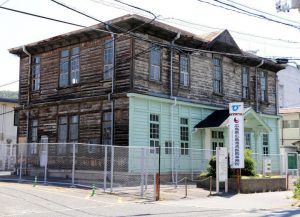Walking tour of A-bombed buildings—Former Hiroshima Prefectural Port Office, located in Hiroshima’s Minami Ward
Aug. 28, 2023
How to fully utilize weathered structure
by Rina Yuasa, Staff Writer
The former Hiroshima Prefectural Port Office, located in the city’s Minami Ward, is the only wooden, Western-style structure built during the Meiji Era that remains in Hiroshima City. The office’s building is highly valued from an architectural standpoint as well. Its appearance recalls the nostalgic atmosphere of a historical port town. The Hiroshima Prefectural government, however, closed the weathered building 12 years ago.
The two-story, symmetrical structure was originally built as the Hiroshima Aquatic Police Station in 1909. Granite was used for its foundation and its semicircular vents lend a unique touch to the structure. In the early days of the building, the front entrance was situated on the south side, near the sea. In 1937, Ujina Police Station (present-day Hiroshima Minami Police Station) took over occupancy of the building; eight years later, the atomic bomb was dropped on Hiroshima.
The building was located 4.6 kilometers from the hypocenter. The roof was lifted in the air by the A-bomb blast, which resulted in some of the beams being broken. The building’s windowpanes were also shattered, scattering glass around. According to The Record of the Hiroshima A-bomb War Disaster, several police officers, including the station chief, immediately went into action and established a first-aid headquarters at the east end of Miyuki Bridge, in the city’s Minami Ward. They are said to have engaged in the work of instructing A-bomb survivors to go to a military hospital (present-day Hiroshima Prefectural Hospital) and providing first aid to the wounded.
The building was registered on the city’s list of A-bombed buildings in 1996, but it has been “vacant” since 2010 due to severe deterioration caused by aging. The Hiroshima Prefectural government considered reutilizing the building as commercial facilities, based on the accumulating high cost of seismic-reinforcement and repair work, but later gave up the idea. The general affairs department of civil engineering and construction work at the Hiroshima Prefectural government said, “We will continue to perform maintenance on the building.”
The Hiroshima City government has registered 86 structures as A-bombed buildings, with an average age of around 150 years old. While the decision was made with backing from the public to preserve the former Army Clothing Depot buildings, among the largest A-bombed structures in the city, the future of many of the structures is uncertain. What value immeasurable by money can be assigned to passing on the A-bomb tragedy to future generations? In what ways can such A-bombed buildings be fully utilized? One thing is certain — once destroyed, the A-bombed structures cannot be recovered.
This article concludes the series “Walking tour of A-bombed buildings.”
(Originally published on August 28, 2023)








